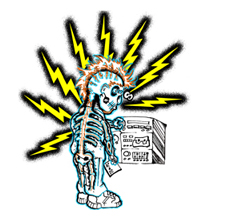
To avoid reflections and “standing waves,” the driver output and receiver input impedances at the physical ends of the cable must equal the characteristic impedance of the cable itself.
Such impedance matching or termination is required for virtually all video and RF cables because the signals have physically small wavelengths. However, termination of audio cables is NOT required until they are some 4,000 feet long!
Noise Coupling
Contrary to popular belief and information offered by cable manufacturers, noise coupling has very little to do with cable shielding.
Nearly all noise problems are caused by a tiny but significant voltage between the grounded ends of the cable. This voltage can be created two ways.
In all real equipment, parasitic capacitances exist between the power line and the internal equipment ground. They are the unavoidable inter-winding capacitances of its power transformer (including external “wall-wart” power supplies) that are never shown in schematic diagrams (Figure 2).
If the equipment contains anything digital, internal electro-magnetic interference (a.k.a. EMI) filters further add to the capacitance.
Leakage current will flow through these capacitances from the power line to the signal/chassis ground inside each piece of equipment. In UL-approved ungrounded (i.e., two-prong AC power plug) devices, this current is limited to 0.75 mil- liamps.
Note that such equipment incorporates a number of protective mechanisms so that it remains safe in spite of internal component failures, overload, and rough handling.
Because it has no safety ground connection, the chassis and/or signal connections can assume alarmingly high voltages with respect to an external ground system. Although a voltmeter may indicate well over 50 volts, the current available is small and will be felt as a slight tingle when it flows through your body.
What’s important, however, is that any connection between two such devices or such a device and a grounded one will conduct this inter-chassis leakage current.
When connecting a signal cable between them, power-line leakage current flows in the grounded signal conductor. Since this conductor does not have zero resistance, a small noise voltage is generated over its length – a simple application of Ohm’s Law.

